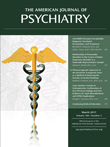T
o the E
ditor: We appreciate the thoughtful comments made by Dr. Nepon and his colleagues. Our recent study found that borderline personality disorder patients with and without PTSD did not significantly differ in the frequency, intent, and lethality of suicide attempts (
1). Nepon et al. point out that this is inconsistent with the results of several recent epidemiologic studies (
2–4). These studies, all published since our manuscript was originally submitted and thus not cited in our article, are to be commended for their use of large-scale, nationally representative samples. As Nepon et al. describe, these epidemiologic studies found that PTSD is associated with a greater risk of suicide attempt after controlling for the effects of borderline personality disorder (
2,
3) and that individuals with both borderline personality disorder and PTSD had a higher rate of lifetime suicide attempt compared to individuals with either disorder alone (
4). Nepon et al. suggest that the discrepant findings between these epidemiologic studies and our study are due to differences in sample size, as our study used a markedly smaller sample.
While we agree that our sample size is certainly a limitation of the study, we do not believe that the lack of between-group difference in suicide attempt frequency in our study can be attributed to the sample's size. In particular, the frequency of past-year suicide attempts was highly similar for borderline personality disorder patients with and without PTSD (yielding only a small between-group effect size), suggesting that the lack of statistical significance was not due to low power.
Instead, we think it is more likely that the discrepant findings are attributable to the nature of the sample rather than its size. Our study (
1) used a clinical sample of women with borderline personality disorder participating in an outpatient treatment study who were selected on the basis of their high degree of suicidality. The study inclusion criteria required that participants exhibit both recent (past 8 weeks) and chronic (at least two episodes in the past 5 years) intentional self-injury (suicide attempts and/or nonsuicidal self-injury), as well as at least one suicide attempt in the past year. In contrast, the epidemiologic studies used community samples that were selected to be representative of the U.S. adult population (
2–4). Given that all of the borderline personality disorder patients in our study had attempted suicide in the past year, our ability to find differences between those with and without PTSD on the frequency, intent, and lethality of past-year suicide attempts was limited by the low degree of variability among participants. In contrast, the rate of lifetime suicide attempt was notably lower in the community samples (3%–4% of the total samples and 18%–32% of the borderline and PTSD subgroups; [
2–4]), thereby providing greater variability and ability to detect between-group differences. Thus, our findings suggest that among suicidal borderline personality disorder patients, the addition of PTSD does not further increase the already high frequency of suicide attempts. The epidemiologic studies, on the other hand, suggest that PTSD does increase the frequency of suicide attempts among borderline personality disorder individu-als in the community who exhibit lower rates of baseline suicidality. Rather than being discrepant findings, we think these studies are simply assessing this issue in very different borderline personality disorder populations.
It is also important to note that the lack of difference in the frequency of suicide attempts that was found in our study is consis-tent with other studies that have utilized clinical as opposed to community samples, even when the clinical samples were not required to exhibit a high degree of suicidality. Yen et al. (
5) used data from the Collaborative Longitudinal Personality Disorders Study (N=621) to examine axis I and II disorders as predictors of prospective suicide attempts. In this treatment-seeking clinical sample, PTSD did not significantly increase the odds of a suicide attempt during the 2 years of follow-up after controlling for the highly significant effect of borderline personality disorder. Similarly, in a clinical sample of 60 women with borderline personality disorder, Rüsch et al. (
6) found that borderline women with and without PTSD did not significantly differ in the lifetime number of suicide attempts. The discrepant findings highlighted by Nepon et al. may be due to the nature of the sample (clinical versus community) rather than its size.
Taken together, the research in this area seems to suggest several important findings. First, individuals with borderline personality disorder and PTSD, in combination or alone, are at heightened risk of attempting suicide and should be carefully assessed and monitored for suicide risk. Second, the impact of co-occurring PTSD on the frequency of suicide attempt among individuals with borderline personality disorder appears to vary depending on the degree of suicidality and treatment-seeking status of the sample. PTSD emerges as a consistent predictor of increased risk of suicide attempts among community borderline personality disorder samples that exhibit lower rates of baseline suicidality, whereas PTSD is not associated with a heightened risk of suicide attempts among suicidal and treatment-seeking borderline personality disorder patients.

